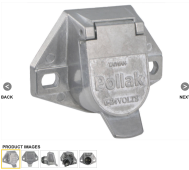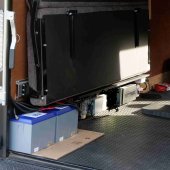I have a van that's a daily driver but also our tow vehicle when we go on long trips with our squaredrop camper. Right now, the whole power system and solar array for it are mounted in/on the camper. I have a cable inlet in the side of the camper that allows me to bring the solar panel cables into the camper to connect to the SCC. I have long extension cables for the panels so that they can be moved around to chase the sun while the camper hides in the shade. When the camper is being towed, the panels are stowed inside and the cables are pulled fully inside the camper.
As part of a major refit to solve some weight and balance problems, I need to move the entire power system into the van instead. The problem I'm struggling with is how to get the cables from the solar panels into the van. I need to achieve basically the same functionality (SCC inside van, cables run out to wherever the solar panels are sitting, no cabling left on the outside of the van while driving) and have no idea how to get the cables through the body of the van. Unfortunately, the panel gaps on the van are too tight to just run the cables out one of the doors.
Does anyone know of a product that'll allow me to connect/detach the solar panels externally in a fully waterproof way that'll not make a mess/inconvenience for the majority of the year where I'm not using the van as a boondocking rig?
As part of a major refit to solve some weight and balance problems, I need to move the entire power system into the van instead. The problem I'm struggling with is how to get the cables from the solar panels into the van. I need to achieve basically the same functionality (SCC inside van, cables run out to wherever the solar panels are sitting, no cabling left on the outside of the van while driving) and have no idea how to get the cables through the body of the van. Unfortunately, the panel gaps on the van are too tight to just run the cables out one of the doors.
Does anyone know of a product that'll allow me to connect/detach the solar panels externally in a fully waterproof way that'll not make a mess/inconvenience for the majority of the year where I'm not using the van as a boondocking rig?





